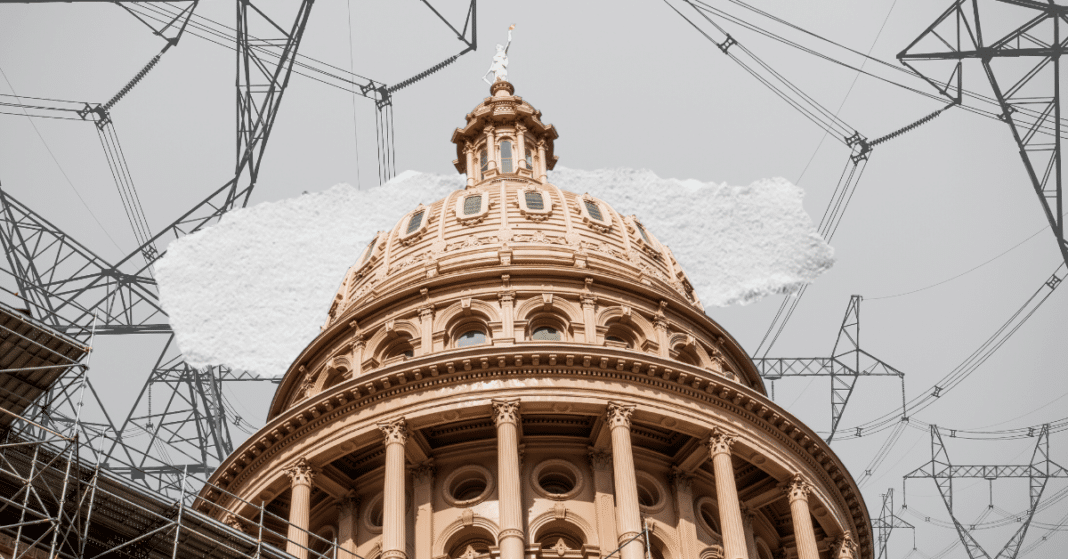The Texas Senate Business & Commerce Committee held more hearings Thursday at the state capitol about how to stabilize the Texas energy market for generating dispatchable electricity to meet the ever-growing demand as the reliability of the state power grid — present and future — is still in question.
The hearing focused on proposed changes to the wholesale electric market design and the impact such changes will have on the reliability of the Texas electric grid in the second winter weather season since Winter Storm Uri, as well as recent electricity outages.
Representatives from the Public Utility Commission (PUC), the Texas Competitive Power Advocates, and Independent Market Monitor groups attended to give testimony and answer questions about the PUC’s recent decision to adopt a new market design known as the Performance Credit Mechanism or PCM.
Once again, concerns were raised in the hearing about the reliability of the proposed new system and its ability to incentivize the construction of electricity-producing plants, and what needs to be done to ensure that the state can avoid another Uri, which crippled the grid and claimed the lives of hundreds of Texans, and caused extensive damage to the grid that Texans will be paying for for years to come.
State Sen. Robert Nichols, R-Jacksonville, during his remarks said “I don’t want to leave this building this legislative session without solving this problem,” and expressed concerns that even members of the legislature still don’t have — or agree on — all the facts, adding that “people in this building have told me things that I’m hearing today aren’t true.”
The political future of all members of the state government may well hinge on whether the committee approves the current Public Utility Commission plan or finds an alternative. Gov. Greg Abbott staked his political credibility on ensuring reliability, claiming that he feels the “winterization” of the grid has been done per Senate Bill 3.
SB 3 requires power generation companies to take steps to better prepare their facilities to withstand extreme weather.
Thankfully, the grid has survived the current winter for the most part, as nothing like the February 2021 disaster has occurred. But experts warn that it’s only a matter of time before the state faces such a calamity again if more investment in the grid’s infrastructure doesn’t occur soon, as some of the current power-generating facilities date back to the Eisenhower administration.
Former PUC Chair Rebecca Klein, Principal of Klein Energy, LLC, and a member of the Saber Partners Advisory Board, was on hand to testify at the hearing to provide a “historical context” from the last market restructuring that occurred when she was a commissioner from 2001-04, as well as chair, and is a current member of the commission.
Committee Chair Sen. Charles Schwertner, R-Georgetown, asked Klien how long she thought it would take to implement PUC’s preferred path forward, the Performance Credit Mechanism. She said that whatever the estimate is, add 50 percent to the time needed.
The Electric Reliability Council of Texas (ERCOT) has estimated it would take two to three and a half years, so if her prediction is accurate, the grid fix won’t occur until toward the end of the current decade.
In an exchange with state Sen. Donna Campbell, R-New Braunfels, Klein agreed with the senator’s assessment that the failure of the grid during Uri was due to the performance of the electricity capacity that existed, plus “inadequate forecasting,” and the “lack of weatherization” that caused the grid’s collapse. Klein cited independent analyst and federal regulator reports that agreed that “it was the performance.”
State Sen. Lois Kolkhorst, R-Brenham, said in last week’s committee hearing that the cost of Uri will be passed on to commercial and residential monthly electric bills, thus Texans will bear the burden of the estimated $10 billion in surcharges, on top of rising electricity rates going forward.
“Look at Uri and what happened, the customers paid a great price. They’re gonna pay it for decades,” Kolkhorst said, later adding that she and her colleagues in the Legislature were elected to “make sure we guarantee there is never a repeat of what we saw in February 2021.”
State Sen. Jose Menendez, D-San Antonio, referenced a Dallas Morning News report that said that in Texas — the nation’s presumed energy capital — 45 percent of Texans are cutting back on food and medical care to pay for rising energy costs in the wake of the last grid failure during Uri.
Menendez also pointed out that renewables, or green energy producers such as wind and solar, have delivered significant savings to the Texas market and consumers, something that at times certain members of the committee seem reluctant to admit.
Schwertner acknowledged the contribution but said that “the only way we can meet that need is by dispatchable generation,” meaning traditional generating plants fired by fossil fuels that create electricity that can be turned off and on as needed.
Much of the discussion of renewable energy centered around the federal government subsidies for renewable energy but failed to mention the subsidies oil and gas companies receive.
And State Sen. Nathan Johnson, D-Dallas, pointed out that ultimately federal subsidies to renewable energy producers, whose technology helps power natural gas plants, regardless of whether that money comes to Texas and benefits both traditional and new energy producers.
The comments seemed to indicate he felt his Republican colleagues like state Sen. Mayes Middleton, R-Galveston, focused too much attention on the “distortion” to the state energy market he has repeatedly claimed renewable energy companies caused.
Michelle Richmond, Executive Director for the Texas Competitive Power Advocates (TCPA), a non-profit trade association that represents power generators and wholesale power marketers, said the group’s members could build more than the required 4,500 megawatts of new gas generation under the PCM and said she feels that the plan will guarantee the mandated reliability of the grid will be met.
Menéndez asked Richmond about the increasingly extreme weather and the age of the state power-generating fleet of plants and asked “wouldn’t the PCM benefit your group of companies more than others?” Richmond responded that the companies in her group would welcome any competition.
The PCM is meant to help produce enough power when in peak demand hours caused by extreme heat or cold when electricity production drops due to a lack of sun or wind to produce renewable energy or equipment breakdowns at the natural gas and coal-fired power plants.
After those peak demand times are identified as “high-risk” hours — utilities and electric retailers that consumed power during those hours — would be required to buy the performance credits from the power generators.
Senators and experts who testified said that the consulting group E3 made errors in the analysis of the PCM system.
Two of those industry experts, Katie Coleman and Charles Griffey, testified on behalf of the Texas Manufacturers Association and the Texas Oil & Gas Association respectively.
Coleman said that the biggest problem with the grid fix is predicting output, including from thermal plants, and demand, as said the models she used in her analysis show the state needs investment in gas “to remain on par” with renewable investment.
Griffey said he believes that E3’s “analysis is not realistic,” and questioned whether supply chains will be able to support that amount of generator plant construction by the projected 2026 mark.
Doug Lewin, energy industry expert and president of Stoic Energy, LLC tweeted during the hearing that “the PCM is…based on adding payments to generators during times of scarcity. It’s an unpredictable revenue stream and I don’t think it’ll actually do that but that’s the intent.”








